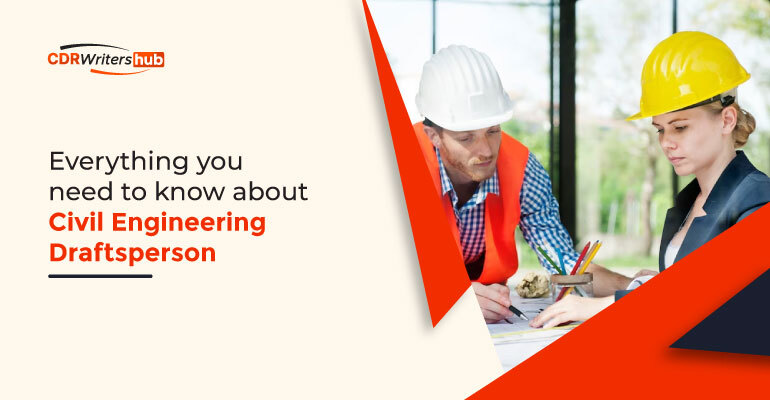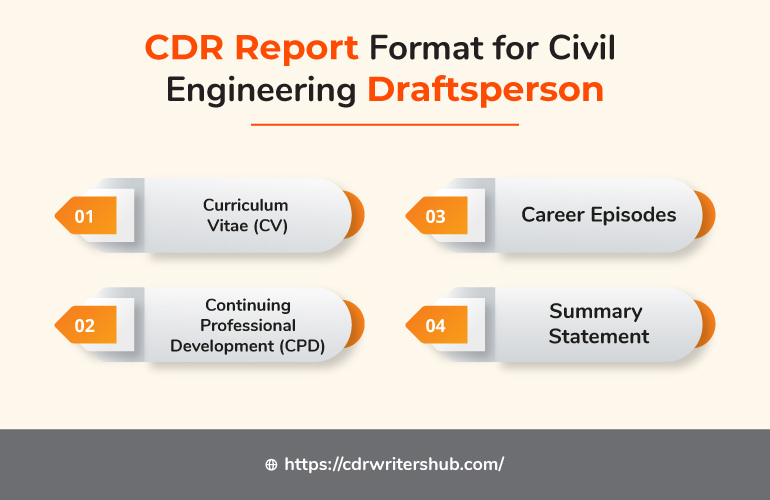Everything you need to know about Civil Engineering Draftsperson

Everything you need to know about Civil Engineering Draftsperson
Welcome to our guide about Civil Engineering Draftspersons. They’re like construction architects, turning complex designs into detailed plans. We’ll show you what they do, the skills they need, and how they make big projects happen. They are the experts who transform complex engineering and architectural designs into precise, detailed technical drawings and plans.
In this blog, we’ll explore Civil Engineering Draftspersons. You’ll learn about their roles and responsibilities, what they do daily, the skills they need, and how they help make construction projects successful.
CDR Report for Civil Engineering Draftsperson
Table of Contents
Competency Demonstration Report (CDR) plays a crucial role in recognizing and assessing the qualifications and skills of Civil Engineering Draftspersons. Whether you are considering a career as a Civil Engineering Draftsperson or curious about their essential role in engineering and construction, this blog will provide a comprehensive overview.
Engineers Australia (EA) uses the CDR to check if engineers, like Civil Engineering Draftspersons (ANZSCO Code: 312211), are qualified to work in Australia. This process ensures people have the qualifications and experience to be engineers in Australia.
But before we get into the details of the CDR report, it’s essential to know what a Civil Engineering Draftsperson does. This knowledge will help you tailor your CDR to align with the expectations and requirements of the profession.
Role of a Civil Engineering Draftsperson
Civil Engineering Draftspersons are experts at making detailed technical drawings, plans, and diagrams for civil engineering projects. They’re vital for turning the ideas of engineers and architects into clear plans for building and infrastructure. These pros are a big deal in the construction industry, ensuring projects happen.
Responsibilities of a Civil Engineering Draftsperson
The responsibilities of a Civil Engineering Draftsperson include:
- Creating detailed technical drawings and plans based on designs provided by engineers and architects.
- Utilizing Computer-Aided Design (CAD) software to produce accurate and comprehensive drawings.
- Collaborating with engineers, architects, and construction teams to ensure project designs are translated into technical drawings.
- Revising and updating drawings as needed throughout a project’s lifecycle.
- It’s important to understand that part of the job is ensuring all drawings and plans meet the local building rules and safety standards. This helps keep construction projects safe and robust.
Knowing this is a big deal when writing your CDR report to show off your skills and abilities.
CDR Report Format for Civil Engineering Draftsperson
The CDR report has different parts, showing how qualified and skilled you are as a Civil Engineering Draftsperson. It’s essential to follow the format they want so your report matches what Engineers Australia is looking for.
1. Curriculum Vitae (CV)
Your CDR report’s first part is about your CV (Curriculum Vitae), and it should give a clear picture of your background and qualifications as a Civil Engineering Draftsperson. Here’s what you need to include:
- Personal Information: Start with your full name, contact details, and any professional memberships or affiliations you have.
- Educational Qualifications: List all your academic qualifications in detail, including the degrees you’ve earned, the names of the institutions where you studied, and the dates when you graduated.
- Employment History: Provide a thorough record of your work history. Include your job titles the dates when you worked in each position, and describe your roles and responsibilities.
- Professional Memberships: Mention any memberships you hold in engineering or related professional organizations.
- Training and Certifications: Include information about any extra training, courses, or certifications relevant to your profession.
- Language Proficiency: If it applies, include details about your English language skills, such as scores from language tests.
A well-structured and informative CV sets the stage for the rest of your CDR report writing.
2. Continuing Professional Development (CPD)
In this part, provide information about your Continuing Professional Development (CPD) activities. CPD is vital for improving your skills assessment as a Civil Engineering Draftsperson (ANZSCO 312211). Engineers Australia appreciates the importance of continuous learning, so your CPD records should show your dedication to staying updated with industry trends and best practices.
When documenting your CPD activities, consider the following:
- Date and Duration: Specify the date and duration of each CPD activity.
- Activity Description: Provide a clear description of each CPD activity, including the title, objectives, and content.
- Relevance: Explain how each CPD activity is relevant to your career as a Civil Engineering Draftsperson and how it contributes to your professional development.
Your CPD records should prove a commitment to lifelong learning and a dedication to staying updated with advancements in your field.
3. Career Episodes
Career Episodes are the heart of your CDR report. These episodes provide detailed accounts of your engineering experiences and accomplishments. As a Civil Engineering Draftsperson, you should include three Career Episodes, each focusing on a particular aspect of your work. Here’s how to structure each Career Episode:
-
Introduction
Each Career Episode should begin with a brief introduction that provides context for the specific project or position you are discussing. Clearly state your role and responsibilities in the project.
-
Background
In this section, provide background information about the project or position. Explain the project’s objectives, significance, and any challenges or issues that must be addressed. Paint a clear picture of the context in which you worked.
-
Personal Engineering Activity
The heart of each Career Episode is the description of your engineering activities within the project or position. In this part, you should showcase your technical skills, problem-solving abilities, and contributions to the project. Be sure to cover:
- The specific tasks and responsibilities that get assigned to you.
- The technical aspects of your work, including CAD software and other tools.
- Any innovations or improvements you introduced.
- Challenges you faced and how you overcame them.
-
Summary
Conclude each Career Episode with a summary highlighting your achievements, skills demonstrated, and lessons learned from the experience. Use this section to reflect on the impact of your contributions.
Creating engaging and detailed Career Episodes is crucial, as they are the primary evidence of your competencies as a Civil Engineering Draftsperson. Be specific, provide clear examples, and focus on the technical aspects of your work.
4. Summary Statement
The Summary Statement is crucial to your CDR report because it connects your Career Episodes to the competency elements set by Engineers Australia (EA). Its primary purpose is to show how your experiences match the elements needed for your chosen engineering category.
In the Summary Statement, you should:
- Cross-reference the paragraphs from your Career Episodes with the relevant competency elements.
- Provide a clear and concise explanation of how each paragraph demonstrates your competency in the corresponding element.
- Ensure that all competency elements required for your chosen occupational category are addressed.
The Summary Statement is your chance to highlight how well you grasp the competency requirements and how your experiences match them. Engineers Australia assessors will review this section to determine if you meet the criteria for professional recognition.
Writing Effective Career Episodes
Career Episodes are a critical part of your CDR report. They provide the evidence that Engineers Australia assessors use to check your engineering competencies. As a Civil Engineering Draftsperson, your Career Episodes should focus on the technical aspects of your work and show your ability to perform engineering tasks.
Let’s explore three sample Career Episodes to help you understand how to create effective ones.
Critical Elements of the CDR Assessment Criteria
Engineers Australia (EA) assesses CDR reports based on specific criteria related to competencies and professionalism. Understanding these criteria is essential for preparing a successful CDR report.
The assessment criteria are categorized into four occupational categories, and as a Civil Engineering Draftsperson, you need to meet the criteria for the specific category you are applying for. Let’s explore the critical elements of each category:
1. Professional Engineer (PE)
The Professional Engineer (PE) category is suitable for engineers who have achieved a significant level of professional experience and responsibility. Key elements of the PE category include:
- Comprehensive, in-depth knowledge and understanding of the principles and concepts in the field of engineering.
- Advanced knowledge in engineering software applications.
- Demonstrated ability to manage complex engineering projects.
- Evidence of leadership and management skills in an engineering context.
Your CDR report should prove your competencies in these critical areas through your Career Episodes, CPD, and Summary Statement to qualify for the PE category.
2. Engineering Associate (EA)
The Engineering Associate (EA) category suits engineers with significant technical expertise and limited project management responsibilities. Key elements of the EA category include:
- Proficiency in the application of engineering principles and practices.
- Advanced technical skills in engineering tasks.
- Demonstrated capability to work in a team.
- Evidence of collaboration and contribution to engineering projects.
If you apply for the EA category, your CDR report should emphasize your technical skills and contributions to engineering projects.
3. Engineering Technologist (ET)
The Engineering Technologist (ET) category suits engineers specializing in specific technical areas and providing technical support in engineering projects. Key elements of the ET category include:
- Specialized knowledge and skills in a specific technical field.
- Proficiency in applying technical principles to engineering tasks.
- Evidence of problem-solving abilities in technical contexts.
- Contribution to the technical aspects of engineering projects.
If you are pursuing the ET category, your CDR report should highlight your specialized technical expertise and contributions to engineering tasks.
4. Engineering Manager (EM)
The Engineering Manager (EM) category is for engineers who have assumed managerial roles focusing on leadership and project management. Key elements of the EM category include:
- Advanced management and leadership skills in engineering.
- Demonstrated ability to plan and execute engineering projects.
- Evidence of effective communication and stakeholder engagement.
- Contribution to the strategic direction of engineering initiatives.
If you seek recognition in the EM category, your CDR report should emphasize your managerial and leadership skills in engineering contexts.
Preparing for the CDR Review
- Once you have prepared your CDR report, reviewing and proofreading it before submission is crucial. Here are some essential steps to prepare for the CDR review:
Proofread for Clarity and Consistency
- Review your CDR report for clarity, coherence, and consistency in language and formatting.
- Check for grammatical errors, typos, and punctuation mistakes.
- Ensure that the report uses technical terminology and acronyms.
Verify Cross-References
- Double-check the cross-references in your report to ensure that paragraphs in your Career Episodes align with the competency elements in your Summary Statement.
- Confirm that all competency elements required for your chosen occupational category are addressed.
Check Document Structure
- Ensure that your CDR report follows the prescribed format and contains all the required sections: CV, CPD, Career Episodes, and Summary Statement.
- Verify that each section gets labeled and follows the recommended order.
Review for Technical Accuracy
- Scrutinize the technical content of your Career Episodes to ensure accuracy and relevance.
- Verify that your experiences and achievements align with the competencies and occupational category you are applying for.
Seek Feedback
- Consider seeking feedback from colleagues, mentors, or professionals in your field to review your CDR report.
- External feedback can provide valuable insights and suggestions for improvement.
Proof of Authenticity
- Ensure that all information in your CDR report is accurate and truthful. Providing any misleading information can lead to severe consequences.
Sample CDR Report for Civil Engineering Draftsperson
We have provided a sample CDR report for a Civil Engineering Draftsperson to further assist you in preparing your CDR report. This sample report follows the format and guidelines outlined in this guide. Reviewing a sample report can help you understand how to structure your own and provide valuable insights into the level of detail required.
Conclusion
Preparing a Competency Demonstration Report (CDR) is very important for Civil Engineering Draftspersons who want recognition for their engineering skills in Australia. This guide has given you a detailed overview of how to make your CDR, including the format, what you need to include, and some tips for success.
To make a strong CDR, follow the advice in this guide. Show your skills and qualifications for skilled migration in Civil Engineering Drafting with specific examples, emphasize your technical abilities, and ensure your report meets Engineers Australia’s criteria for your job category.
As you work on this, remember that careful preparation and attention to detail are crucial to success. Good luck with your goal of becoming a recognized Civil Engineering Draftsperson in Australia!



